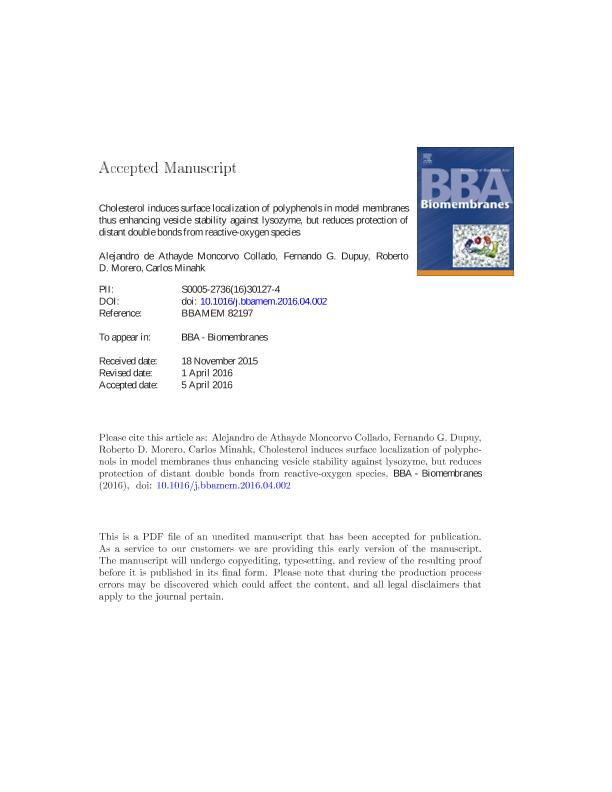Mostrar el registro sencillo del ítem
dc.contributor.author
de Athayde Moncovo Collado, Alejandro

dc.contributor.author
Dupuy, Fernando Gabriel

dc.contributor.author
Morero, Roberto Dionisio

dc.contributor.author
Minahk, Carlos Javier

dc.date.available
2018-07-04T20:44:24Z
dc.date.issued
2016-07
dc.identifier.citation
de Athayde Moncovo Collado, Alejandro; Dupuy, Fernando Gabriel; Morero, Roberto Dionisio; Minahk, Carlos Javier; Cholesterol induces surface localization of polyphenols in model membranes thus enhancing vesicle stability against lysozyme, but reduces protection of distant double bonds from reactive-oxygen species; Elsevier Science; Biochimica et Biophysica Acta - Biomembranes; 1858; 7; 7-2016; 1479-1487
dc.identifier.issn
0005-2736
dc.identifier.uri
http://hdl.handle.net/11336/51271
dc.description.abstract
The main scope of the present study was to analyze the membrane interaction of members of different classes of polyphenols, i.e. resveratrol, naringenin, epigallocatechin gallate and enterodiol, in model systems of different compositions and phase states. In addition, the possible association between membrane affinity and membrane protection against both lipid oxidation and bilayer-disruptive compounds was studied. Gibbs monolayer experiments indicated that even though polyphenols showed poor surface activity, it readily interacted with lipid films. Actually, a preferential interaction with expanded monolayers was observed, while condensed and cholesterol-containing monolayers decreased the affinity of these phenolic compounds. On the other hand, fluorescence anisotropy studies showed that polyphenols were able to modulate membrane order degree, but again this effect was dependent on the cholesterol concentration and membrane phase state. In fact, cholesterol induced a surface rather than deep into the hydrophobic core localization of phenolic compounds in the membranes. In general, the polyphenolic molecules tested had a better antioxidant activity when they were allowed to get inserted into the bilayers, i.e. in cholesterol-free membranes. On the other hand, a membrane-protective effect against bilayer permeabilizing activity of lysozyme, particularly in the presence of cholesterol, could be assessed. It can be hypothesized that phenolic compounds may protect membrane integrity by loosely covering the surface of lipid vesicles, once cholesterol push them off from the membrane hydrophobic core. However, this cholesterol-driven distribution may lead to a reduced antioxidant activity of linoleic acid double bonds.
dc.format
application/pdf
dc.language.iso
eng
dc.publisher
Elsevier Science

dc.rights
info:eu-repo/semantics/openAccess
dc.rights.uri
https://creativecommons.org/licenses/by-nc-sa/2.5/ar/
dc.subject
Fluorescence Anisotropy
dc.subject
Langmuir Monolayers
dc.subject
Lipid Oxidation
dc.subject
Liposome Leakage
dc.subject
Liposomes
dc.subject
Polyphenols
dc.subject.classification
Otras Ciencias Biológicas

dc.subject.classification
Ciencias Biológicas

dc.subject.classification
CIENCIAS NATURALES Y EXACTAS

dc.title
Cholesterol induces surface localization of polyphenols in model membranes thus enhancing vesicle stability against lysozyme, but reduces protection of distant double bonds from reactive-oxygen species
dc.type
info:eu-repo/semantics/article
dc.type
info:ar-repo/semantics/artículo
dc.type
info:eu-repo/semantics/publishedVersion
dc.date.updated
2018-06-28T13:58:11Z
dc.journal.volume
1858
dc.journal.number
7
dc.journal.pagination
1479-1487
dc.journal.pais
Países Bajos

dc.journal.ciudad
Amsterdam
dc.description.fil
Fil: de Athayde Moncovo Collado, Alejandro. Consejo Nacional de Investigaciones Científicas y Técnicas. Centro Científico Tecnológico Conicet - Tucumán. Instituto Superior de Investigaciones Biológicas. Universidad Nacional de Tucumán. Instituto Superior de Investigaciones Biológicas; Argentina
dc.description.fil
Fil: Dupuy, Fernando Gabriel. Consejo Nacional de Investigaciones Científicas y Técnicas. Centro Científico Tecnológico Conicet - Tucumán. Instituto Superior de Investigaciones Biológicas. Universidad Nacional de Tucumán. Instituto Superior de Investigaciones Biológicas; Argentina
dc.description.fil
Fil: Morero, Roberto Dionisio. Consejo Nacional de Investigaciones Científicas y Técnicas. Centro Científico Tecnológico Conicet - Tucumán. Instituto Superior de Investigaciones Biológicas. Universidad Nacional de Tucumán. Instituto Superior de Investigaciones Biológicas; Argentina
dc.description.fil
Fil: Minahk, Carlos Javier. Consejo Nacional de Investigaciones Científicas y Técnicas. Centro Científico Tecnológico Conicet - Tucumán. Instituto Superior de Investigaciones Biológicas. Universidad Nacional de Tucumán. Instituto Superior de Investigaciones Biológicas; Argentina
dc.journal.title
Biochimica et Biophysica Acta - Biomembranes

dc.relation.alternativeid
info:eu-repo/semantics/altIdentifier/doi/https://dx.doi.org/10.1016/j.bbamem.2016.04.002
dc.relation.alternativeid
info:eu-repo/semantics/altIdentifier/url/https://www.sciencedirect.com/science/article/pii/S0005273616301274
Archivos asociados
